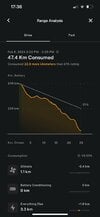Hello,
My 2019 Model X LR is used for short distances occasionally and has relatively few kms (32,000 km - 20,000 miles) on it. In order to maximize battery life I always charged at home using low amperage within a 20-75% regime.
Recently I started using the car more often and its range was really low like 55% of the brand new / published range. I communicated with Tesla and asked for a battery replacement from warranty but they said the battery was fine. They suggested that I fully charge the car and do some long distance driving so the battery will recondition itself. I was suspicious because I thought I was being dismissed however several long distance drives (but on the shorter end like 300 km / 200 miles) made some difference so the range has gone up to around 75%.
My question is does short (or very short) distance driving degrade the battery and can the opposite be true for long distance driving? I'm familiar with the factors that diminish range such as speed, elevation, acceleration, temperature but never considered driving distance to be a factor.
Thanks for your sharing your experience and advice!
My 2019 Model X LR is used for short distances occasionally and has relatively few kms (32,000 km - 20,000 miles) on it. In order to maximize battery life I always charged at home using low amperage within a 20-75% regime.
Recently I started using the car more often and its range was really low like 55% of the brand new / published range. I communicated with Tesla and asked for a battery replacement from warranty but they said the battery was fine. They suggested that I fully charge the car and do some long distance driving so the battery will recondition itself. I was suspicious because I thought I was being dismissed however several long distance drives (but on the shorter end like 300 km / 200 miles) made some difference so the range has gone up to around 75%.
My question is does short (or very short) distance driving degrade the battery and can the opposite be true for long distance driving? I'm familiar with the factors that diminish range such as speed, elevation, acceleration, temperature but never considered driving distance to be a factor.
Thanks for your sharing your experience and advice!



